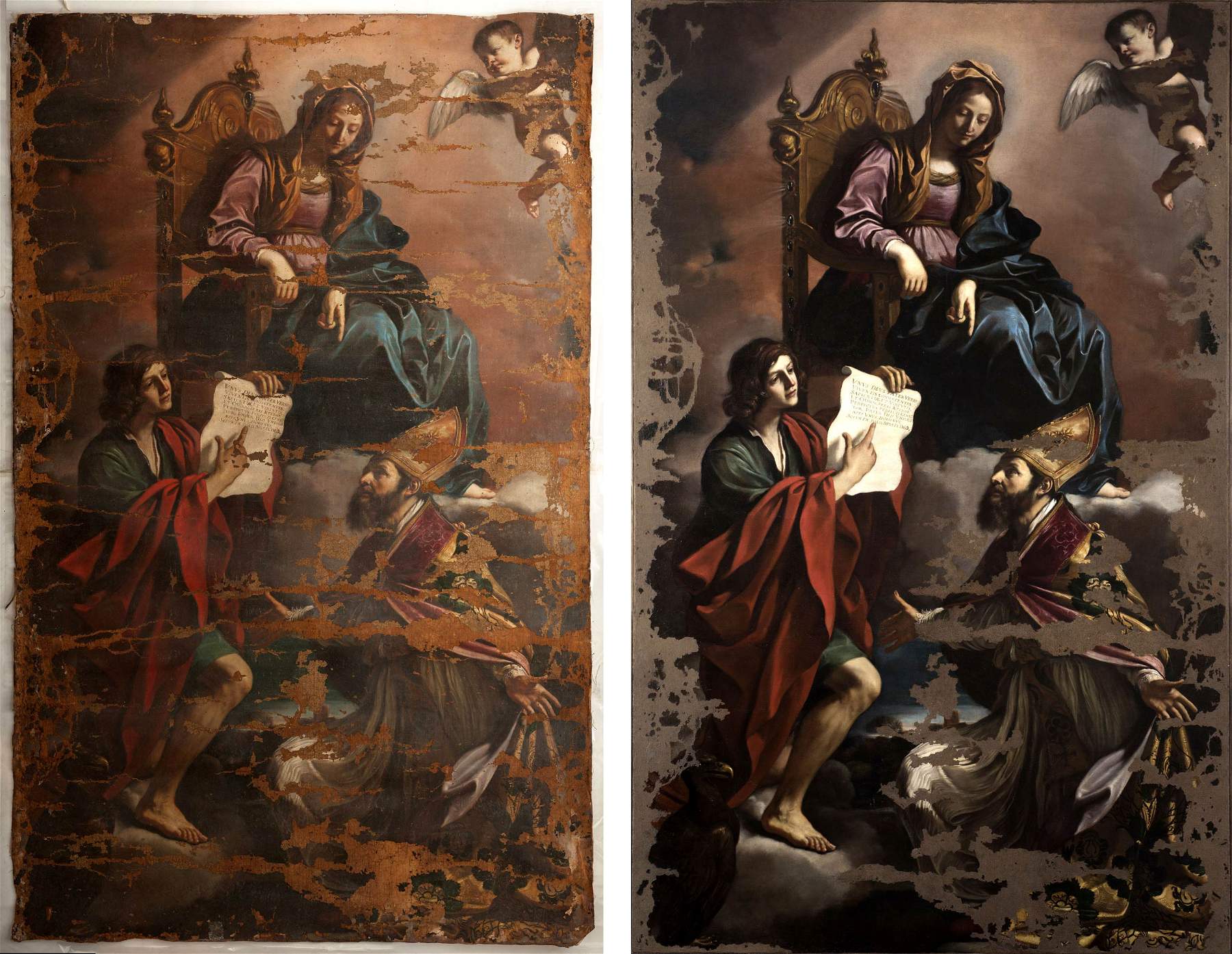It has been back on view for a few days, the Madonna and Child with Saints John the Evangelist and Gregory the Wonder worker by Guercino (Giovanni Francesco Barbieri; Cento, 1591 - Bologna, 1666), the work stolen in 2014 from the church of San Vincenzo in Modena and found in Casablanca, Morocco, in 2017, in critical condition: in fact, the canvas had lost about 30 percent of its painted surface. Immediately subjected to a lengthy restoration curated by theIstituto Superiore per la Conservazione e il Restauro (ISCR), initially directed by Maria Grazia Gattari of the Bologna Superintendency and then by Angelandreina Rorro of the ISCR, the work, which has just been shown to the public at the Galleria Estense in Modena, has aroused strong controversy.
Indeed, critics have pointed the finger at the failure to reinstate many of the gaps. Acting as a sounding board for the criticism a few days ago was critic Philippe Daverio from the pages of Il resto del Carlino, who said, “technically, given the missing parts, I don’t think the restoration would have been particularly difficult for a professional. And there is still time: I hope that someone other than me will raise the issue and push the authorities to hire a restorer to complete the operation.” In short: according to Daverio (and many others), the Guercino canvas needed to be restored to how it was before the 2014 theft.
And precisely on the restoration is a clash between Maria Grazia Gattari and Luigi Ficacci, director of the ISCR. Ficacci diffused the ISCR’s reasons (the work involved several professionals: Carla Zaccheo and Francesca Capanna were responsible for the technical direction and operational phases of the restoration, Angelo Raffaele Rubino took care of the photographic documentation, the chemical investigations were conducted by Fabio Talarico and the physical ones by Fabio Aramini) in a note signed together with Rorro and Zaccheo. “The considerable damage sustained during the well-known events of the theft and the exiicial windings in the opposite direction with the pictorial film facing inward,” said Ficacci, Rorro and Zaccheo, “made it necessary to carry out a preliminary fixing functional to the handling and laying on the work surface set up to perform the subsequent restoration operations. These consisted of the removal of the old and heavy lining and the application of a new lining, the cleaning of the surface with the removal of the superimposed substances (oxidized varnishes, plastering and altered retouches applied during previous restorations, residues of sedimented dust layers) and the aesthetic presentation.”
Regarding the failure to reintegrate the missing portions, Ficacci, Rorro and Zaccheo explained that “in the search for a new balance, the impossibility of total reintegration of the gaps was noted, their morphology and their context of formal relationship were carefully evaluated. The objective of the current intervention has therefore been to manage the inescapable fact of the gaps, reducing as far as possible their potential for visual interference, rather than reiterating subjective interpretations or yielding to the impulse of expectations of restoration responding to the criterion of ’as it was, where it was.’ In proceeding therefore by priority, progressively assessing the level of sustainable balance achieved and while taking into account the legitimate expectations of enjoyment of the image, a unified criterion was identified by distinguishing between reintegrable and non-reintegrable gaps. The restoration was also an opportunity to identify and bring to light some original parts of the painting that had been concealed by previous retouches.”
Not of the same opinion is Maria Grazia Gattari, who already pointed out in an interview with Finestre sull’Arte in October 2017, responding to a clear question about the restoration of the gaps, that “we cannot leave the gaps empty. A very talented work like this must be reconstructed to give the proper overall reading.” The official reiterated her thoughts in an interview published yesterday in Il resto del Carlino, where she talks about work being conducted in violation of the Cultural Heritage Code. “At the beginning, when the director of the Institute for Restoration was Gisella Capponi,” she told the Bologna daily, “I had an initial meeting with the restorers and it seemed that our directives could be accepted. Then, since Luigi Ficacci took over as director, I was no longer able to carry out the necessary inspections. It was explained to me that everything was proceeding well and that there was no need for my presence. All this, in my opinion, was in violation of Article 21 of the Cultural Heritage Code, which provides for the supervision and necessary inspections by the superintendence of all restoration work in the public interest.”
On the issue of gaps, Gattari speaks of restoration that cannot be considered complete. “It is still possible to complete the restoration,” the official concludes, “although there are not a few bureaucratic difficulties that should be faced.”
Pictured: Guercino, Madonna and Child with Saints John the Evangelist and Gregory the Wonderworker, before and after restoration (1629-1630; oil on canvas, 293 x 184.5 cm; Modena, San Vincenzo)
 |
| Guercino restoration before and after, it's a clash. Ficacci: no to the way it was where it was. Gattari: incomplete work |
Warning: the translation into English of the original Italian article was created using automatic tools. We undertake to review all articles, but we do not guarantee the total absence of inaccuracies in the translation due to the program. You can find the original by clicking on the ITA button. If you find any mistake,please contact us.